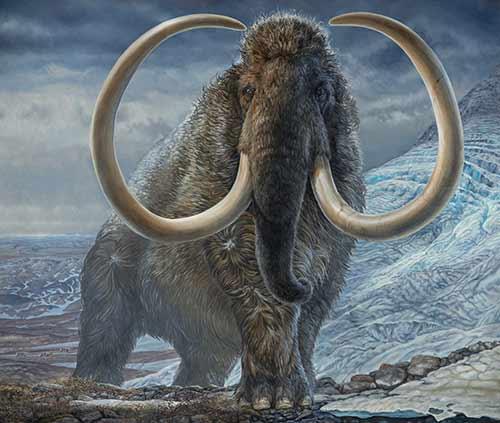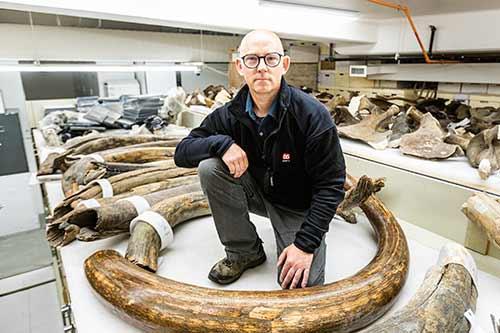
Analysis of a 17,000-year-old fossil has revealed remarkable details about the travel patterns of an Arctic woolly mammoth who, throughout its 28-year life, walked the equivalent of nearly two trips around the world.
Little was known about the lives and movements of woolly mammoths until an international team of researchers conducted detailed genetic and isotopic analyses of a male mammoth tusk and reconstructed its lifetime journey. Their findings are outlined in the new issue of the journal Science.
Read the general release from University of Alaska Fairbanks.
It’s not clear-cut if it was a seasonal migrator, but it covered some serious ground,” said University of Alaska Fairbanks researcher Matthew Wooller, senior and co-lead author of the paper. “It visited many parts of Alaska at some point during its lifetime, which is pretty amazing when you think about how big that area is.”
Wooller notes that learning about the lives of extinct species satisfies more than curiosity.
“The Arctic is seeing a lot of changes now, and we can use the past to see how the future may play out for species today and in the future. Trying to solve this detective story is an example of how our planet and ecosystems react in the face of environmental change.”

Amy Willis, assistant professor of biostatistics at the University of Washington School of Public Health and an expert in statistical modeling, was a member of the research team.
Willis and her colleague Clément Bataille, an isotope expert from the University of Ottawa, developed a sophisticated isotope-guided random walk approach to track the mammoth's movements.
“We leave an imprint on the world and the world leaves its imprint on us. All living creatures, as they move about, incorporate aspects of the landscape into their bodies. We truly carry our life history embedded in our molecules,” said Willis.
Willis and Bataille analyzed the isotopic signatures of strontium in the mammoth’s tusk and compared them with isotope variation across Alaska.
“As the animal roamed, the strontium isotope of the locations he passed through were incorporated into and preserved in his tusk. As he aged, and his tusks grew, more and more of the landscape left an imprint on his body, and we used the strontium profile in his tusk for our model of his mobility,” said Bataille.

The model developed by Bataille and Willis first determines where the mammoth was likely to have been a week before its death by identifying a location where the strontium signal in the landscape was similar to the strontium signal at the base of the tusk.
But many places in Alaska have similar strontium signals, and so other factors had to be used to narrow the number of potential routes. For example, the mammoth couldn’t climb sheer cliff faces, traverse glaciers or travel hundreds of kilometers in a week (to get some sense of how far a mammoth might travel in a week, Willis and Bataille looked at travel patterns of modern elephants and caribou).
But even with these constraints, there were still many places that were good matches for the location of the mammoth a week before his death, so the team randomly picked one then moved one week further up the tusk to see where it would lead.
“We repeated this again and again, stepping through the tusk, to reconstruct the whole life of the mammoth. We constructed thousands of walks, taking a different randomly chosen, but isotopically guided, step at each point in the walk,” said Willis.
This process produced around 5,000 highly plausible walks. The team then ranked these strontium-guided random walks using oxygen isotope data. When they analyzed walks that matched the strontium, oxygen, and distance travelled constraints, they could see consistent patterns — including highly frequented areas and seasonal north-south mobility.
“It’s incredible that we can get any insight at all into where an animal walked thousands of years ago. The fact that the world leaves this imprint on the body of this animal that we can discover tens of thousands of years later and use to understand detailed aspects of its life and its movements is just amazing,” said Willis.
“I’m excited to see what other remnants of ancient or extinct life are out there, and to hear from scientists who discover insights into the biodiversity of the past using our model,” said Willis.
Other institutions contributing to the study included Florida State University, Montanuniversität Leoben, Liaocheng University and the National Park Service.
- Deb Nelson, UW Biostatistics Communications
ADDITIONAL CONTACTS: Matthew Wooller, 907-750-8786, mjwooller@alaska.edu; Clement Bataille, 832-943-8588, cbataill@uottawa.ca